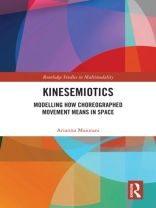This innovative work introduces the interdisciplinary field of research of kinesemiotics, offering a new adaptable model and means of analysis for understanding forms of movement-based communication, such as dance, that use a codified language shared by a community of users.
It begins with a theoretical overview and review of existing literature on the main approaches to movement-based communication, specifically dance, which underpin kinesemiotics as an area of study. It reaffirms previous work which established dance as a form of embodied communication in that it encompasses a wide range of semiotic styles and forms shared by communities of ‘speakers.’ In collaboration with the English National Ballet, Maiorani employs the genre of ballet as a means through which to understand and analyse some of the key concepts of kinesemiotics, mainly that of space as a semiotic dimension and ‘motivated movement, ‘ or movement with meaning. Supported by automated movement recognition tools from the fields of bio-robotics engineering and computer science, Maiorani argues for ballet’s capacity, when movements are projected into meaningful space, to extend beyond sequences of physical movements to become a meaning making practice.
Kinesemiotics advances interdisciplinary research in the fields of social semiotics, media and communication, multimodality, linguistics, and performance studies and will be of particular interest to students and scholars in these areas.












